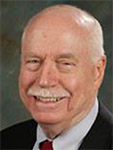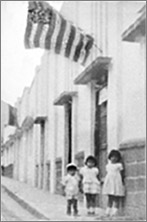11/22/63 — Ask not . . . by Jerry Norris (Colombia)

Jerry Norris (Colombia 1963-65)
As a Peace Corps Volunteer, I was assigned to La Plata, a difficult to find village on any map, set in the foothills of Colombia’s Andean mountains. On this soon to be fateful morning of November 22, 1963 I had taken a bus into Neiva, the Departmental capital, to obtain some governmental authorizations for Community Development Funds for one of our projects. Like most every bus in our area, firmly set above the driver’s head were three pictures with Christmas tree lights around them: Jesus, the Virgin Mary, and President John F. Kennedy. Later that afternoon, about 3:30 PM or so, before boarding the bus for the trip back, I stopped at a newsstand next to the Hotel Neiva to see if it had a recent copy of Time Magazine. There was one copy left!
In my excitement to read while paying for it, I paid little attention to a wildly gesturing sales clerk, arms all akimbo, shouting at me in desperation words like muerto (dead), John F. Kennedy, asesino (assassinated), en la cabeza (in the head), and jabbing his fingers to his head for added effect.Thinking the man was either deranged or just anti-American I gave him no attention, and left rather than create a scene. He kept shouting after me, obviously quite upset at my dismissive attitude. I was self-absorbed, focused entirely on having Time Magazine all to myself before having to share it with my site partners.
Upon arriving in La Plata, I noticed the streets were empty in the main plaza, but a huge crowd had formed at the front door of our house just down the street. Some 3,000 people lived in La Plata and they all seemed to be at our front door! My first thought was that something had happened to my site partners, Frank and Steve. As I moved closer, the crowd made way for me. No one spoke. Some reached out to put a gentle hand on my shoulder, lightly touch my hand, or to murmur something as I passed by, their faces prefiguring something that had to be unspeakable. No thought crossed my mind about anything the sales clerk had shouted to me in Neiva.
Once inside our house, I went into a room where my site partners were seated. I was relieved to see that they looked just fine, no different than when I had left them earlier that day. They were huddled over a small short-wave radio, saying nothing, but moving to make room for me to sit next to them. Now, seeing them up close, they appeared stunned and were furiously working the radio to pick up clear stations. They tried BBC, then VOA, then Radio Cali and Bogota. At each stop on the dial, brief bursts of news came through: shots in Dallas, Texas; the President was in a hospital; then Air Force One was taking off for Washington, D. C. We couldn’t connect the dots.
At one point, the front door opened and plates of food and coffee were silently slipped in to us. No faces, just extended arms.
Before midnight, there was a gentle knock on the door. It was the Mayor. He asked if we might take a moment to step outside. Upon doing so, it became clear that the entire town of La Plata was out there. The Mayor, hesitant, cleared his throat for what must have been a long minute before finally reading a Proclamation expressing a deep and profound sorrow on the part of every citizen in La Plata for the incomprehensible news that ”the sons of John F. Kennedy now had to bear”.

Dona Lucia’s children in front of our house in La Plata, with flag made by her the night of JFK’s assassination.
The three of us still had not understood fully what had happened. We stood there rather bewildered. Then, Dona Lucia Perez, a woman who lived down the street, stepped forward. She asked us to look back and upward to our front door. There, stretched above it was an American flag. To make sure we could see it in the darkness, everyone who had a flashlight put their beams onto it. The effect of all those lights in that mid-night environment was rather surreal. It was at this point that our denial finally gave way to the inevitable and we connected the dots: the man, who with one simple request “ask not …,” had compelled us to reach into the unknown was no longer with us. Although we were surrounded by what seemed the entire population of La Plata, we now felt alone.
Soon afterwards, my site partners completed their tours and returned home, entrusting the flag to my care. It is 4’ x 4’ in dimensions, made of rayon. Where Dona Lucia, a poor woman, obtained the materials to stitch the materials together without a sewing machine by the dim light of a candle, and how she knew that it had to have 13 bars and 50 white stars on a field of blue in the upper left hand corner, I never knew — nor asked. Over the next 18 months of my assignment in La Plata, along with two new site partners, Andy and Bob, we became one with her family of 8 children. Whenever there was meat on the table, it went first to her beloved husband, Don Luis, a one-eyed itinerant field worker—and none of us complained. Their house had no TV or radio . . . familial love seemed to be the main form of communication.
Back home I flew the flag from the front door of our home in Washington, D. C. every Memorial Day, July 4th and Veterans Day, and I still often take it to reunions of our Peace Corps group. In spite of its exposure to wind, sun and sudden thunderstorms over the past 58 years, it has never required any repairs. When I see it, this flag reminds me of JFK’s admonition that “the burden of a long twilight struggle” is ever with us, its outcome always uncertain, painful and costly.
— Jerry Norris, Colombia Group VI, Co-ops, 1963–65
Thank you. Unknowingly, I was nearby, ville restrepo, Tolima, those days. Our village thought Président Kennedy had selected Marge and I to go to Colombia, if not Villa restrepo, and that the PC would end with death of President Kennedy. The next day Marge and I took bus to Tolima to be one of special guests at funeral mass.
That night on the arrival home, a small group asked if they could meet in the morning. Of course, yes
That morning they said they had a meeting while we were in the city. They decided they wanted us to stay there beyond the ending of peace corps. And had this plan. Families a, b .and c would each provide one egg a week, similar re banana, orange, had arranged with bus. Driver freeRT to Ibaque weekly and the most moving – a weekly airmail stamp so we could writehome
Joan,
Villa Restrepo was one of the veredas in which I worked when I was a volunteer in Chapeton. Still remember the route well all the way to Juntas and over the mountain (8 hours by macho) to Toche. Trying to remember the family I was closest to there. I was close to Padre Sanchez and Tulia his sister.
You take me down nostalgia lane/
Best,
G.
Dear Mr. Norris,
I am an historian at the University of Richmond, currently researching a history of US cooperatives and international development in the second half of the 20th century. One of my book chapters focuses on CLUSA and Peace Corps cooperative work in Latin America during the 1960s.
I’ve listened to your terrific JFKL oral history, but was wondering if you might be willing to talk with me in greater detail about your post-PCV work for Peace Corps/Washington?
Thank you for considering!
Nicole Sackley
Nicole,
On December 7, I just got your note of November 29. Yes, I would be willing to discuss with you my work in Peace Corps Washington which took place after my Volunteer time in Colombia, working on the establishment of ag cooperatives. My cell number is: 202-290-5935.
Best wishes,
Jerry Noris